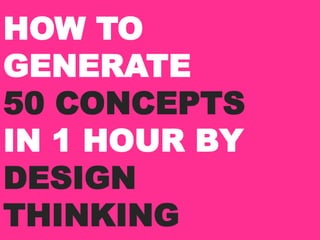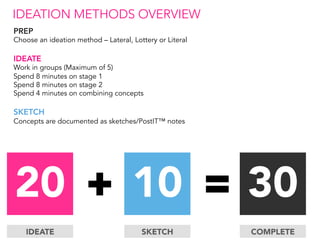HOW TO GENERATE 50 CONCEPTS IN 1 HOUR by DESIGN THINKING
- 1. HOW TO GENERATE 50 CONCEPTS IN 1 HOUR BY DESIGN THINKING
- 3. A CONCEPT IS A SUCCINCT DESCRIPTION OF AN BELIEVABLY UNBELIEVABLE INNOVATION
- 4. WHAT TO DO?
- 5. 1.  A LIST OF PROBLEMS 2.  A LIST OPPORTUNITIES 3.  GROUP(S) OF 5 PEOPLE 4.  A GOOD SIZED ROOM 5.  LOTS OF STATIONERY 6.  LOTS OF ENERGY 7. …60 MINUTES YOU NEED…. Â
- 6. 1. BUILD ON… 2. STAY LOOSE… 3. DONT COMMIT… 4. DIVERGE FROM… 5. KEEP THE PACE UP… 6. AND NAME YOUR CONCEPTS… EVERYONE SHOULD… Â
- 7. 1608 STORYTELL 08 SKETCH + = COMPLETE THE METHOD SLIDES TELL YOU HOW LONG SHOULD SPEND ON EACH ACTIVITY IN MINUTES KEEP TO TIME… Â
- 9. 1608 STORYTELL 08 SKETCH + = COMPLETE PARTICIPATORY STORYTELLING PREP Split into pairs/triads Split pairs/triads into a) Listener and b) Storyteller groups STORYTELL Storytellers assume the identity of a customer/user Storytellers Tell A Story of their imagined current/future experience Listeners ask questions and look for opportunities to change/improve the experience SKETCH Teams back come together and brainstorm ideas Concepts are documented as sketches/Post IT™ notes Â
- 10. IDEATION 30
- 11. 3020 IDEATE 10 SKETCH + = COMPLETE IDEATION METHODS OVERVIEW PREP Choose an ideation method – Lateral, Lottery or Literal IDEATE Work in groups (Maximum of 5) Spend 8 minutes on stage 1 Spend 8 minutes on stage 2 Spend 4 minutes on combining concepts SKETCH Concepts are documented as sketches/PostIT™ notes
- 12. METHODS
- 13. IDEATION METHOD | LATERAL | Using stimuli STAGE 1 Spend 8 minutes listing the essential features of the following things: Airport e.g. connects with other transportation…etc. Racehorse e.g. is trained for speed…etc. Glacier e.g. is different when seen from above…etc. Butler e.g. is always attentive.. STAGE 2 Spend 8 minutes applying each of the essential features to your problem/opportunity as a potential solution E.g. Airport. connects with…other users, other features such as calendar etc. STAGE 3 Concepts are documented as sketches PRINTOUT1  2008 STAGE 1 08 STAGE 2 + = COMPLETE 04 STAGE 3 +
- 14. IDEATION METHOD | LOTTERY | Using random input  STAGE 1 Spend 8 minutes brainstorming your topic around one contrast word pairs below: E.g. How to make the problem/opportunity… Better vs. Worse e.g. Social Media posts content without you knowing Faster vs. Slower e.g. Emails are sent by traditional post Functional vs. Emotional e.g. My TV knows my mood and shows me content STAGE 2 Spend 8 minutes applying each of the contrasting features as a potential solution to your problem/opportunity E.g. Worse, Automated posting…preferences….set reminders… STAGE 3 Concepts are documented as sketches PRINTOUT2  2008 STAGE 1 08 STAGE 2 + = COMPLETE 04 STAGE 3 +
- 15. IDEATION METHOD | LITERAL | Unpicking the problem  STAGE 1 Spend 8 minutes unpicking problem/opportunity features and definitions E.g. A car is: A mode of transport A status symbol A danger STAGE 2 Spend 8 minutes applying each of the features and definitions as a potential solution to your problem/opportunity E.g. Status symbol…Something I wear, change every year, recycle when used… STAGE 3 Concepts are documented as sketches PRINTOUT3  2008 STAGE 1 08 STAGE 2 + = COMPLETE 04 STAGE 3 +
- 16. CONSOLIDATE
- 17. 1005 LONG LIST 05 SHORT LIST + = COMPLETE LONG TO SHORT LIST LONG LIST Reread the brief/problem statement Brainstorm ideas (build and diverge) and document them on Post It™ notes SHORT LIST Categorise your ideas by arranging them in an Affinity Diagram E.g. x axis Hard vs. Easy and y axis Innovative vs. Boring Agree on the strongest idea and use a flipchart sheet to document it as a Concept Poster



















